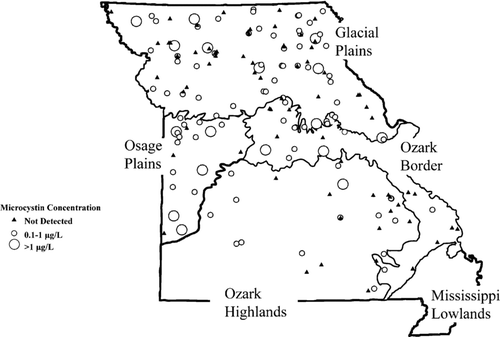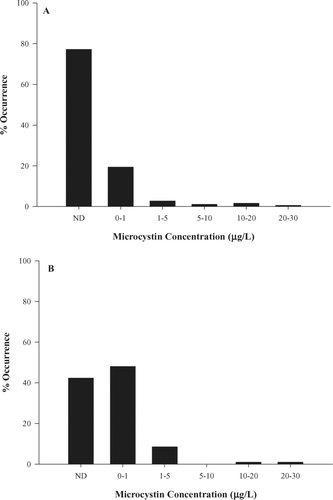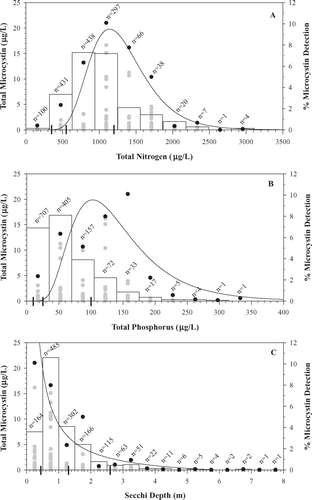Figures & data
Table 1 Provincial medians (med) and ranges of landscape, morphological, and limnological variables.
Table 2 Regional means, medians, and maxima of total microcystin values. Summary statistics are based on samples collected in each region.
Figure 1 Physiographic location of reservoirs sampled in Missouri and total microcystin occurrence and concentration.

Figure 2 Occurrence and concentration of total microcystin in Missouri reservoirs. The World Health Organization (WHO) microcystin guidelines for finished drinking water and full-body contact recreation are 1 and 20 μg/L, respectively. (A) Occurrence and concentration among samples (n = 1402), (B) occurrence and concentration among reservoirs (n = 177).

Table 3 Monthly means, medians, and maxima of total microcystin values. Summary statistics are based on samples collected during each month.
Table 4 Annual means, medians, and maxima of total microcystin values. Summary statistics are based on samples collected during each year.
Table 5 Trophic class means, medians, and maxima of total microcystin values. Summary statistics are based on samples collected in each trophic class.
Table 6 Comparison of environmental variables among three microcystin concentration categories: no detectable microcystin (nd), total microcystin concentrations between 0.1–1 μg/L (0.1–1), and total microcystin concentrations greater than 1 (> 1). Significant differences between means were determined using one-way ANOVA and Tukey's pairwise comparisons.
Figure 3 Total microcystin (MC), total nitrogen (TN), total phosphorus (TP) and Secchi bivariate relations. Data shown as grouped into intervals for interval-maxima regression (IMR). Curves were estimated using IMR. Black points indicate the data used for IMR analysis (n = 8–16) and gray points indicate all other data. Bar graphs represent frequency distributions of MC detection within each interval used for IMR. Hash marks on the x-axes indicate oligotrophic/mesotrophic, mesotrophic/eutrophic and eutrophic/hypereutrophic cutpoints for Missouri reservoirs as defined by Jones et al. 2008a. (A) MC–TN relation (r2 = 0.87, p < 0.01, values for line fitted to black points only), (B) MC–TP relation (r2 = 0.75, p < 0.01), (C) MC–Secchi relation (r2 = 0.93, p < 0.01). All n = 1402.
